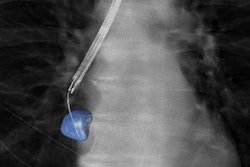Dear Advanced Visualization Insider,
Hematoma expansion in spontaneous intracerebral hemorrhage is associated with a poor prognosis. However, CT radiomics and a machine-learning model can predict hematoma growth with a high level of accuracy, potentially enabling preventive interventions in these patients, according to researchers from China.
They shared their results in a presentation at the recent Conference on Machine Intelligence in Medical Imaging, held by the Society for Imaging Informatics in Medicine. Our coverage of the research is the subject of this edition's Insider Exclusive.
In other news, researchers from Europe have concluded that there's currently an evidence gap for the use of many available automated volumetric MRI reporting applications for diagnosis of dementia. After systematically reviewing published evidence, they found that less than 25% of the companies that had received regulatory clearance for their quantitative volumetric reporting tools for dementia assessment had published any clinical validation of their software. And none had reported any workflow integration or evaluation of the software in clinical practice.
Bronchoscopy guided by conebeam CT and "augmented" fluoroscopy can be highly accurate in biopsying peripheral lung lesions. Also, a 3D CT reconstruction helped diagnose a rare tumor in a 17-year-old with jaw pain and swelling. Plus, a computer-aided navigation system was used by clinicians in Japan to successfully perform temporomandibular joint ankylosis surgery on a pediatric patient.
Radiomics continues to show promise for differentiating lesions, potentially helping to avoid unnecessary biopsies. For example, an Italian team's predictive model yielded high accuracy and specificity for differentiating malignant from benign breast lesions on dynamic contrast-enhanced MRI. In addition, radiomics and a machine-learning algorithm produced strong performance for differentiating between benign masses and renal cell carcinoma on preoperative CT.
MRI radiomics can also help to predict whether hormone receptor-positive breast cancer patients will respond to endocrine therapy.
New interventional oncology guidelines should increase research on image-guided procedures and standardize patient care, according to a recent report. Also, collateral blood flow in stroke patients can be assessed with CT perfusion imaging and an artificial intelligence algorithm.
Using an electronic protocol process can significantly speed up the start times for breast localization procedures. Finally, body composition analysis on CT exams has revealed that colon cancer patients with high visceral fat and low muscle mass are more likely to have worse outcomes. Inflammation was also a key factor.
Is there a story you'd like to see covered in the Advanced Visualization Community? Please feel free to drop me a line.




















